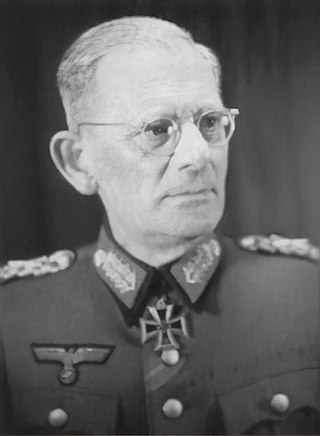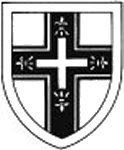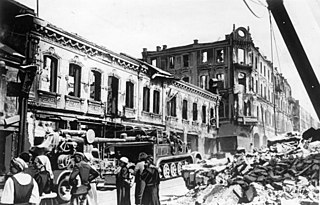
Ernst Bernhard Wilhelm Busch was a German Generalfeldmarschall during World War II who commanded the 16th Army and Army Group Centre.
Generalfeldmarschall was a rank in the armies of several German states and the Holy Roman Empire (Reichsgeneralfeldmarschall); in the Habsburg monarchy, the Austrian Empire and Austria-Hungary, the rank Feldmarschall was used. The rank was the equivalent to Großadmiral in the Kaiserliche Marine and Kriegsmarine, a five-star rank, comparable to OF-10 in today's NATO naval forces.

Moritz Albrecht Franz Friedrich Fedor von Bock was a German Generalfeldmarschall who served in the German Army during the Second World War. Bock served as the commander of Army Group North during the Invasion of Poland in 1939, commander of Army Group B during the Invasion of France in 1940, and later as the commander of Army Group Center during the attack on the Soviet Union in 1941; his final command was that of Army Group South in 1942.

Georg Carl Wilhelm Friedrich von Küchler was a German Generalfeldmarschall of the Wehrmacht during the Second World War, who was subsequently convicted of war crimes. He commanded the 18th Army and Army Group North during the Soviet-German war of 1941–1945.

Maximilian Maria Joseph Karl Gabriel Lamoral Reichsfreiherr von und zu Weichs an der Glon was a German Generalfeldmarschall in the Wehrmacht of Nazi Germany during World War II.

Günther Adolf Ferdinand von Kluge was a German Generalfeldmarschall during World War II who held commands on both the Eastern and Western Fronts. He commanded the 4th Army of the Wehrmacht during the invasion of Poland in 1939 and the Battle of France in 1940, earning a promotion to Generalfeldmarschall. Kluge went on to command the 4th Army in Operation Barbarossa and the Battle for Moscow in 1941.

Wilhelm List was a German Generalfeldmarschall during World War II who was convicted of war crimes by a US Army tribunal after the war. List commanded the 14th Army in the invasion of Poland and the 12th Army in the invasions of France, Yugoslavia and Greece. In 1941 he commanded the German forces in Southeast Europe responsible for the occupation of Greece and Yugoslavia. In July 1942 during Case Blue, the German summer offensive in Southern Russia, he was appointed commander of Army Group A, responsible for the main thrust towards the Caucasus and Baku.

Johannes Albrecht Blaskowitz was a German Generaloberst during World War II. He was a recipient of the Knight's Cross of the Iron Cross with Oak Leaves and Swords. After joining the Imperial German Army in 1901, Blaskowitz served throughout World War I, where he earned an Iron Cross for bravery.

Army Group North was the name of three separate army groups of the Wehrmacht during World War II. Its rear area operations were organized by the Army Group North Rear Area.

A Generaloberst was the second-highest general officer rank in the German Reichswehr and Wehrmacht, the Austro-Hungarian Common Army, the East German National People's Army and in their respective police services. The rank was equal to a four-star full general but below a general field marshal. The rank was equivalent to a Generaladmiral in the Kriegsmarine until 1945 or to a Flottenadmiral in the Volksmarine until 1990. It was the highest ordinary military rank and the highest military rank awarded in peacetime; the higher rank of general field marshal was awarded only in wartime by the head of state. In general, a Generaloberst had the same privileges as a general field marshal.

The Battle of Tuchola Forest was one of the first battles of World War II, during the invasion of Poland. The battle occurred from 1 September to 5 September 1939 and resulted in a major German victory. Poor Polish command and control, as well as German numerical and tactical superiority, allowed the Germans to manage to cripple Poland's Armia Pomorze and, by breaking through the Polish Corridor, to connect mainland Germany with East Prussia.

The 4th Army was a field army of the Wehrmacht during World War II.

The 61st Infantry Division was a combat division of the German Army during the Second World War. Towards the end of the war, it became the 61st Volksgrenadier Division.
Army Group B was the name of four distinct German army group commands that saw action during World War II.

The Battle of Białystok–Minsk was a German strategic operation conducted by the Wehrmacht's Army Group Centre under Field Marshal Fedor von Bock during the penetration of the Soviet border region in the opening stage of Operation Barbarossa, lasting from 22 June to 9 July 1941.
The Battle of Różan, otherwise known as defence of Różan bridgehead, took place between the 4 and 6 September 1939, in the fields before the town of Różan on the Narew River. A small Polish garrison of three World War I forts successfully defended the bridgehead against the entire German panzer division for the entire day and night. However, as a result of a misunderstanding of the commander in chief's orders, the Polish forces were then withdrawn to the other side of the river, and then further eastwards on the 6 September.

The I Army Corps was a corps of the German army during World War II. It was active between 1934 and 1945, and participated in the Invasion of Poland, the Battle of France and the campaigns on the Eastern Front before eventually ending the war trapped in the Courland Pocket.
The XIX Army Corps was an armored corps of the German Wehrmacht between 1 July 1939 and 16 November 1940, when the unit was renamed Panzer Group 2 and later 2nd Panzer Army. It took part in the Invasion of Poland and the Battle of France.
The XXI Army Corps, also at times designated Group Falkenhorst and Group XXI, was a corps of the German Heer during World War II. It was first deployed on 10 August 1939 in Wehrkreis I in East Prussia. It participated in Operation Weserübung in early 1940. Later that year, it became Armeegruppe XXI. In 1941, the XXI Army Corps was restructured to an army-level unit, Armee Norwegen. In 1943, another corps-level unit carrying the ordinal number 21 was created, the XXI Mountain Corps.
The 228th Infantry Division was an infantry division of the German Heer during World War II. It was formed in Wehrkreis I in August 1939 and was dissolved in August 1940.















